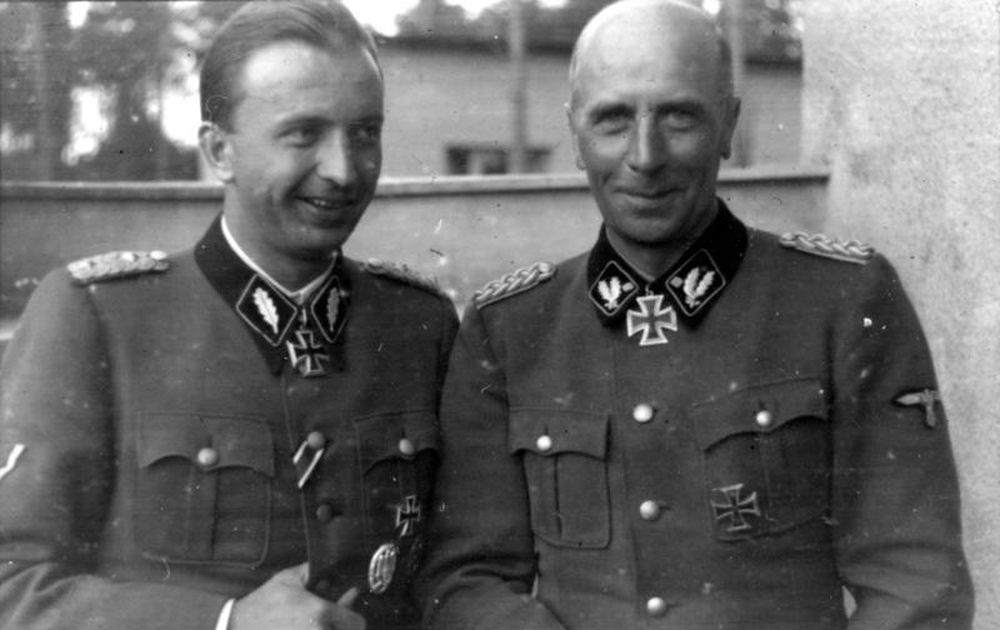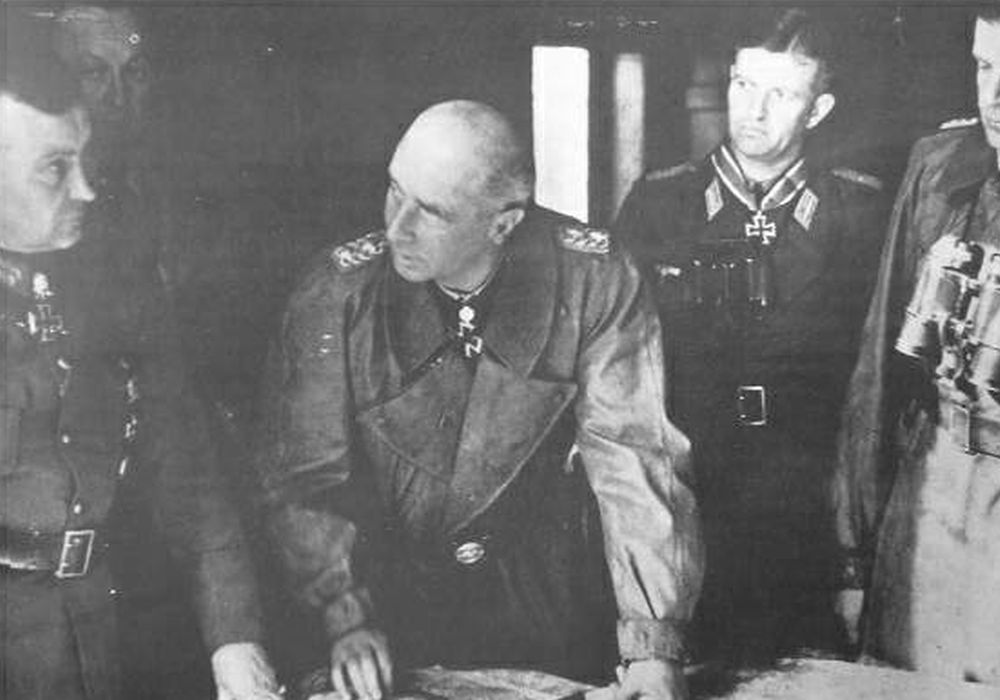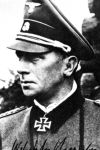Summary
Born on February 26th, 1894, Wilhelm Bittrich served during the First World War both in the Heer and in the Fliegertruppe. Between both wars he was involved in the secret building of the new Luftwaffe. After Adolf Hitler took over power in Germany, Wilhelm Bittrich entered the SS-Verfügunstruppe, later the Waffen-SS. During Operation Market Garden his troops played a vital roll in the German defence. He died on April 19th, 1979 in Bavaria.
Definitielijst
- First World War
- Took place from 1914 till 1918 and is also named The Great War. The conflict started because of increased nationalism, militarism and neo-colonialism in Europe. Two alliances battled one another during the 4-year war, which after a dynamic start, resulted into static trench warfare. The belligerents were the Triple Alliance (consisting of Great-Britain, France, and Russia; later enlarged by Italy and the USA, amongst others) on the one hand and the Central Powers (consisting of Germany, Austria-Hungary, Bulgaria and the Ottoman empire) on the other hand. The war was characterized by the huge number of casualties and the use of many new weapons (flamethrowers, aircraft, poison gas, tanks). The war ended in 1918 when Germany and its allies surrendered unconditionally.
- Heer
- German army or land forces. Part of Wehrmacht together with “Kriegsmarine” and “Luftwaffe”.
- Luftwaffe
- German air force.
- Waffen-SS
- Name of Military section of the SS.
First World War
Wilhelm Bittrich was born February 26, 1894 in Wernigerode in the Harz in the federal state of Saxony-Anhalt.
At the outbreak of World War One, Wilhelm Bittrich reported as a volunteer and was posted to Infanterie-Regiment 77. In 1944 he was gravely wounded. In October 1915, he was promoted to Leutnant der Reserve and in 1916, he made the transition to the Fliegertruppe, scoring three aerial victories in Jagdstaffel 37 (fighter squadron). Bittrich was awarded the Iron Cross 2 and 1 for his achievements in World War One.
Definitielijst
- Iron Cross
- English translation of the German decoration Eisernes Kreuz.
- Regiment
- Part of a division. A division divided into a number of regiments. In the army traditionally the name of the major organised unit of one type of weapon.
- squadron
- A military unit in the Belgian navy usually six to eight small ships operating together under one command. The smallest military unit in the Dutch air force of about 350 men. In most countries is the designation of a military unit thesize of a company. It is either an independent unit, such as a battery, or part of a bigger Calvary unit. In the air force it is the designation of a unit of aircrafts.
Interbellum
After World War One he joined the Freikorps Hülsen and found employment as a sports instructor and with a real estate agency for a short while. On December 29, 1922, he married actress and director Käte Sonntag-Blume. Between 1924 and 190 he was a flight instructor in the Stettiner Sportclub GmbH in Stettin-Krekow and at the German school for commercial pilots in Schliessheim near Munich. On April 1, 1932 he was commissioned in the Reichswehr as a civilian. Here he resumed his job as flight instructor and was sent to Lipezk in the Soviet Union where future Luftwaffe personnel was being trained in secret at the time.
In 1932, one promotion followed the other: Bittrich was a member of the SA from March to June. July 1 he joined the SS (Nr. 39177) as SS-Anwärter (apprentice) in SS-Fliegerstaffel Ost and his promotion to SS-Mann followed on July 15. He was promoted to SS-Oberscharführer on September 10, and subsequently to SS-Sturmführer on October 31, and appointed Führer of his Fliegerstaffel. He joined the N.S.D.A.P. on December 1, 1932 (Nr. 829 700).
Wilhelm Bittrich joined the SS-Verfügungstruppe in 1934 and was promoted to SS-Obersturmführer on April 21. He was charged with the establishment of 1. Batallion/SS-Standarte Germania and on June 17, 1934 he was promoted to SS-Hauptsturmführer. A promotion to SS-Sturmbannführer followed on October 1, 1936 and subsequently he was appointed Kommandeur II. Batallion/SS Regiment Deutschland. He was promoted again on January 30, 1938, this time to SS-Obersturmbannführer. June 1, 1939, he was appointed Führer, Stab Leibstandarte SS Adolf Hitler and June 6, 1939, saw his promotion to SS-Standartenführer.
Definitielijst
- Batallion
- Part of a regiment composed of several companies. In theory a batallion consists of 500-1,000 men.
- Freikorps
- German paramilitary units established directly after the Great War by former front soldiers. These groups were often named after their commander. Freikorps formed the basis of the eventual SA or Sturmabteilung.
- Führer
- German word for leader. During his reign of power Adolf Hitler was Führer of Nazi Germany.
- Germania
- The capital of the Third Reich after the war. Designed by Albert Speer, but never realised.
- Leibstandarte
- Elite troops, originally Hitler’s body guards. Starting as a motorized infantry regiment it grew into a Panzer division.
- Luftwaffe
- German air force.
- Regiment
- Part of a division. A division divided into a number of regiments. In the army traditionally the name of the major organised unit of one type of weapon.
- Reichswehr
- German army during the Weimar republic.
- Soviet Union
- Soviet Russia, alternative name for the USSR.
World War Two
Between October 15 and December 31, 1941 he was in command of 2. SS-Panzer-Division Das Reich, replacing Paul Hauser who had been injured. October 19, 1941 he was promoted to SS-Brigadeführer and Generalmajor der Waffen-SS. On May 1, 1942, Bittrich was ordered to transform the SS-Kavalerie-Brigade to an SS-Kavalerie-Division which would ultimately become the 8. SS-Kavalerie-Division Florian Geyer. During the invasion of the Soviet Union, Bittrich was in command of this division from August 1942 until February, 1943 and subsequently he was appointed commander of the 9. SS-Panzergrenadier-Division Hohenstaufen. He was promoted to SS-Gruppenführer and Generalleutnant der Waffen-SS. During the deployment of this Panzergrenadier-Division in Belgium and France, it was transformed to 9. SS-Panzer-Division in October 1943, taking part in the battles of II. SS-Panzerkorps near Tarnopol in the Soviet Union from March 1944 onwards. June 19, 1944 he was replaced as commander of Hohenstaufen by SS-Standartenführer Thomas Müller.

Hermann Fegelein (left) and Wilhelm Bittrich (right) in the summer of 1942 Source: Bundesarchiv Bild_101III-Bueschel-056-13
July 31, 1944, Bittrich was appointed Führer of II. SS-Panzerkorps. In command of 9. SS-Panzer-Division Hohenstaufen, 3. Fallschirmjäger-Division and units of 21. Panzer-Division, he blocked the Allied advance towards Caen in Normandy. Bittrich was also instrumental in the escape of units of 7. Armee and 5. Panzerarmee from the Falaise pocket on August 20 and 21.
In order to have his troops rest and reorganize, Bittrich and his II. Panzerkorps were sent to the area around Arnhem. During the battle for Arnhem, he was co-responsible for the encirclement of the British 1st Airborne Division in Arnhem. From December 16, 1944 onwards, II. Panzerkorps was subordinate to 6. Panzerarmee commanded by Sepp Dietrich (Bio Dietrich) and took part in the Ardennes offensive. During this operation, Bittrich was in command of his old 9. SS-Panzer-Division Hohenstaufen, the 2. SS-Panzer-Division Das Reich and the Führer-Begleit-Brigade. In February 1945, his theatre of operations was shifted to Hungary. At the end of the Second World War, he and his Korps conducted the defense of Vienna between April 2 and 13. At the end of this battle, Bittrich and the remainder of his troops retreated westwards and he was made a prisoner-of-war by the Americans on May 8, 1945.
Bittrich was awarded the following decorations for his achievements during World War Two: the clasps to the Iron Cross 2 and 1 (September 25, 1939 and June 7, 1940 respectively), the Ritterkreuz (Knight’s Cross), December 14, 1941, Eichenlaub (Oak Leaves) August 28, 1944, Eichenlaub und Schwertern (Swords) May 6, 1945 and the Deutsches Kreuz in Gold (German Cross in Gold) in 1943 among others.
Definitielijst
- Ardennes offensive
- Battle of the Bulge, “Von Rundstedt offensive“ or “die Wacht am Rhein“. Final large German offensive in the west from December 1944 through January 1945.
- Brigade
- Consisted mostly of two or more regiments. Could operate independently or as part of a division. Sometimes they were part of a corps instead of a division. In theory a brigade consisted of 5,000 to 7,000 men.
- Fallschirmjäger
- German paratroopers. Part of the Luftwaffe.
- Führer
- German word for leader. During his reign of power Adolf Hitler was Führer of Nazi Germany.
- invasion
- Armed incursion.
- Iron Cross
- English translation of the German decoration Eisernes Kreuz.
- Leibstandarte
- Elite troops, originally Hitler’s body guards. Starting as a motorized infantry regiment it grew into a Panzer division.
- offensive
- Attack on a smaller or larger scale.
- Regiment
- Part of a division. A division divided into a number of regiments. In the army traditionally the name of the major organised unit of one type of weapon.
- Soviet Union
- Soviet Russia, alternative name for the USSR.
- Waffen-SS
- Name of Military section of the SS.
After the Second World War
In January 1948, Bittrich had himself extradited to France at his own request because of his alleged order to execute 17 resistance fighters in Nimes. During the proceedings, it transpired he had never given such an order and had even taken disciplinary measures against the officers responsible for the executions. As commander he was held accountable for the actions of his subordinates though and sentenced to 5 years imprisonment but released soon after because of his lengthy detention pending trial. On June 16, 1953 he was tried a second time and sentenced to 5 years for executions but the French court of appeal in Bordeaux acquitted him and he was released in 1954. He settled down near Lake Starnberg in southern Bavaria and was unfit for work due to illness.
He passed away on April 19, 1979 in Wolfartshausen in Bavaria.
Definitielijst
- resistance
- Resistance against the enemy. Often also with armed resources.
Information
- Article by:
- Wilco Vermeer
- Translated by:
- Arnold Palthe
- Published on:
- 19-01-2025
- Feedback?
- Send it!
Sources
- BERGER, F., Mit Eichenlaub und Schwertern, Selbstverlag Florian Berger, Wien, Österreich, 2003.
- FELLGIEBEL, W.P., Die Träger des Ritterkreuzes des Eisernen Kreuzes 1939-1945, Podzun-Pallas Verlag, Eggolsheim-Bammersdorf, 2000.
- MüHLEISEN, H. e.a., Die SS, Elite unter dem Totenkopf, Schöningh, Paderborn, 2000.
- PATZWALL, K. & SCHERZER, V., Das Deutsche Kreuz 1941-1945, Band II, Verlag Klaus D. Patzwall, Norderstedt, 2001.
- SCHERZER, V., Die Ritterkreuzträger 1939–1945, Scherzers Miltaer-Verlag, Jena, 2005.











